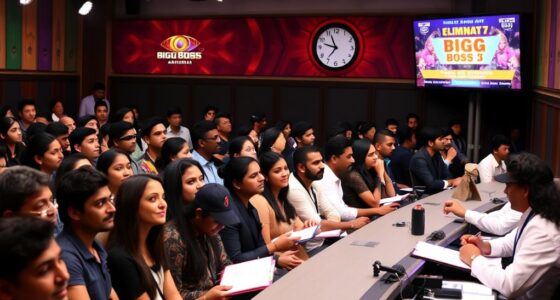A Bollywood hit or flop depends on many factors. Your movie’s box office success hinges on star power, genre appeal, marketing strategy, and regional influence. Audience demographics, external events, and franchise strength also play key roles. If you want to understand what drives these outcomes and how filmmakers navigate these elements, sticking with this can reveal what truly shapes Bollywood’s box office hits and flops.
Key Takeaways
- Box office revenue benchmarks vary, with hits crossing ₹50-100 crore domestically and flops earning significantly less.
- Star power, genre choice, and franchise familiarity heavily influence audience attraction and film success.
- Regional and cultural themes boost appeal, especially in Telugu and Tamil markets, expanding the audience base.
- Strategic marketing, release timing, and festival releases enhance visibility and box office performance.
- External factors like pandemics, OTT competition, and economic shifts can significantly impact box office outcomes.
Key Metrics and Performance Indicators
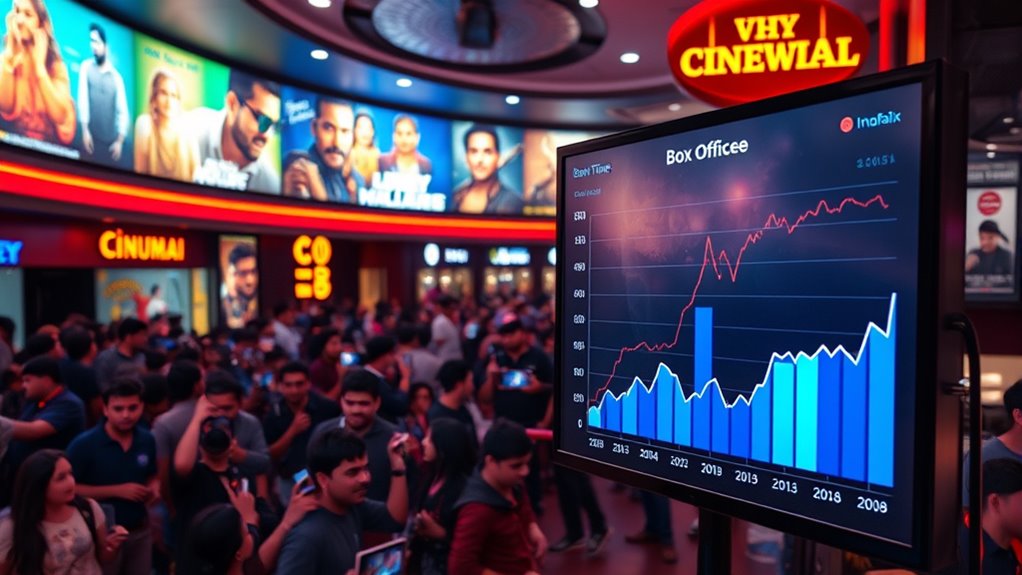
Understanding key metrics and performance indicators is essential to gauge a film’s success at the box office. Your first focus should be on box office gross, which is the total revenue a film earns. Keep in mind that domestic and worldwide collections are tracked separately, with domestic often being more relevant for Bollywood. Post-pandemic, crossing ₹50 crore is now seen as a significant achievement, whereas earlier, crossing ₹100 crore was the traditional benchmark for a hit. Watch for films like “Pushpa 2” or “Chhaava” that gross over ₹500 crore domestically. Additionally, consider production and marketing costs—high-budget films need higher earnings to be profitable. Tracking audience reception and critical reviews can also influence a film’s long-term performance and cultural impact. The overall success of a film can also be influenced by its release timing and competition from other titles. Monitoring these metrics helps you understand whether a film is performing well and if it’s likely to be a hit or a flop. Moreover, tracking audience reception and critical reviews can provide further insight into a film’s long-term performance and cultural impact. A comprehensive analysis of these factors, including box office trends, enables industry stakeholders to make informed decisions regarding film investments and marketing strategies.
Impact of Star Power and Cast Composition

Star power plays a crucial role in shaping a film’s box office performance, as the participation of top-tier actors can draw audiences and boost revenue. When A-listers star in a movie, it often enhances marketing efforts and creates buzz, increasing ticket sales. However, recent trends show that films without major stars can also succeed, highlighting changing audience preferences. The cast’s composition matters too—blending established stars with emerging talent can broaden appeal and elevate the film’s overall attractiveness. A well-chosen cast, combined with good timing and strong chemistry, boosts box office results. Additionally, the economic influence of stars extends beyond the screen, impacting endorsements and brand visibility. Emerging talent has become increasingly important in today’s industry, as audiences are now more receptive to innovative storytelling and fresh faces. The inclusion of diverse cast members can also appeal to wider demographics and enhance market reach. Ultimately, while star power remains influential, innovative content and effective marketing are increasingly shaping a film’s success.
Genre Preferences and Content Trends

Your choice of genre can profoundly influence a Bollywood film’s box office success, with action and hybrid films often drawing larger audiences. Content trends like socially relevant stories and regional themes are also shaping viewer preferences and boosting revenues. By understanding these evolving genre preferences and cultural influences, you can better predict which films are likely to succeed or flop. Action films perform disproportionately well in Asian markets, highlighting the importance of regional genre preferences in box office performance. Additionally, audience engagement techniques such as innovative storytelling and marketing strategies can significantly impact a film’s commercial outcome. Incorporating human-centered methodologies can help filmmakers tailor content that resonates deeply with diverse audiences, further enhancing box office potential. Recognizing the role of creative practice in developing compelling narratives can also contribute to a film’s success. Moreover, market research plays a crucial role in understanding audience tastes and predicting trends, helping filmmakers adapt their strategies accordingly. Utilizing targeted audience analysis can provide deeper insights into regional and demographic preferences, increasing the likelihood of commercial success.
Popular Genre Trends
Have Bollywood’s genre preferences shifted in recent years? Absolutely. Action films like “War 2” and “Singham Again” continue to draw crowds with their high-energy sequences. Comedy franchises such as “Housefull 5” and “Hera Pheri 3” attract large audiences with familiar humor and beloved characters. Drama and thrillers like “Raid 2” keep viewers hooked with gripping stories, while horror movies like “Bhool Bhulaiyaa 3” show a sustained interest in supernatural themes. Additionally, patriotic and sports films like “Gadar 2” appeal to national pride and enthusiasm. Trends in sequels and franchises are strong, with established brands like “Gadar 2” benefiting from loyal fans. Content-wise, pan-Indian collaborations and special effects-driven films like “Fighter” reflect current industry priorities. Audience preferences now favor diverse genres and compelling stories over star power alone. Moreover, the focus on notable titles and box office success influences industry strategies and content creation. The industry is also paying close attention to emerging audience preferences, such as the desire for genre diversity, which continues to shape film production. Changes in content trends are evident as filmmakers explore new narrative formats and blend genres to meet evolving audience expectations. For example, incorporating traditional elements like regional music and storytelling can also enhance the appeal of modern films. Furthermore, the recent cybersecurity challenges faced by big studios underscore the importance of protecting digital content and data security in the industry.
Cultural and Regional Themes
How have regional and cultural themes influenced Bollywood’s evolving genre preferences? They’ve pushed Bollywood to diversify beyond traditional romance and action. Regional films introduce authentic stories rooted in local cultures, resonating deeply with audiences and encouraging Bollywood to explore new genres. The success of regional cinema, especially from South India, has shown that culturally specific content can achieve international recognition and boost box office earnings. This influence is evident in Bollywood’s adoption of regional-inspired themes, remakes, and collaborations. Additionally, the incorporation of regional music styles and storytelling techniques has enriched the diversity of Bollywood productions, making them more appealing to a global audience.
Impact of Franchise Films
Regional and cultural themes have broadened Bollywood’s storytelling landscape, paving the way for genre diversity. Franchise films now dominate the box office, thanks to strong brand loyalty and predictable returns. You’ll notice action and adventure lead the charge, with high-octane espionage and epic historical battles drawing big crowds. Strong male leads, like Tiger and Baahubali, outperform ensemble casts, highlighting audience preferences. Content trends focus on interconnected stories, crossovers, and high production values, including CGI and international shoots, to boost appeal. These films often blend patriotism, humor, and romance, broadening their reach. Key factors include: 1. Popularity of established franchises like YRF Spy Universe and Baahubali 2. Crossovers generating hype and increasing box office numbers 3. Focus on high-quality visuals and interconnected storylines 4. Audience demand for familiar, high-stakes entertainment 5. The incorporation of innovative storytelling techniques to keep audiences engaged. Additionally, the integration of dream-inspired narratives and visual effects enhances the immersive experience and broadens audience appeal.
Regional and Language Market Dynamics
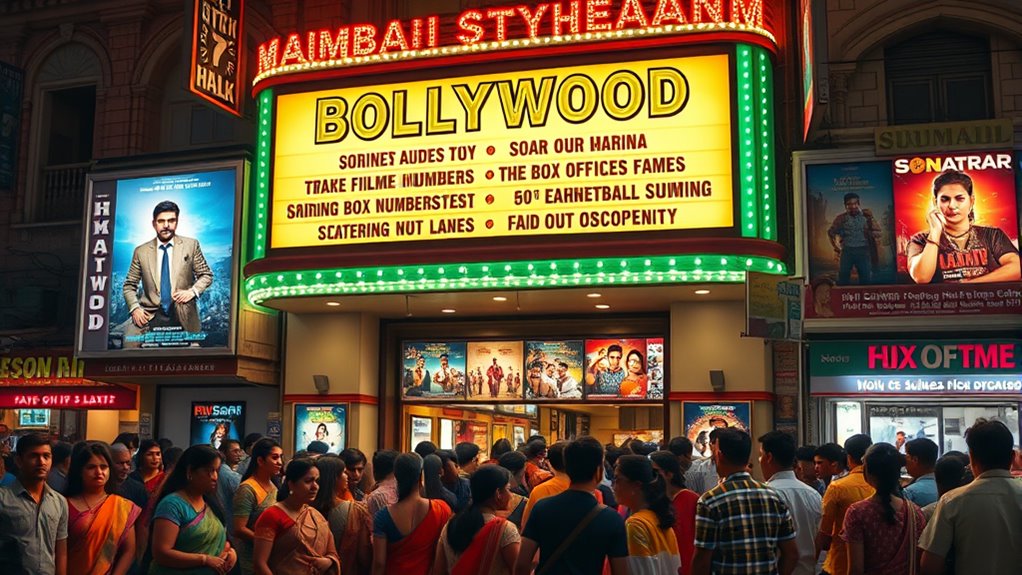
The dominance of regional languages in India’s film and media landscape is reshaping market dynamics profoundly. You’ll notice Hindi films still lead with 44% of the box office in 2023, but regional films, especially Telugu and Tamil, are rapidly growing—together accounting for over half the box office in 2024. Regional languages, spoken by diverse communities, hold cultural significance and attract dedicated audiences. TV viewership reflects this shift, with less than half tuning into Hindi content, while regional language channels like Telugu, Tamil, and Kannada dominate. Digital platforms boost regional content’s reach, encouraging investment and showcasing local stories. This evolving landscape emphasizes localization and content tailored to regional tastes, making regional films and media key players in India’s entertainment industry. Decoding slang helps audiences better understand colloquial expressions used in regional content, further enhancing viewer engagement and cultural authenticity.
Marketing Strategies and Release Timing

Marketing strategies and release timing play a pivotal role in shaping a film’s box office success in Bollywood today. Your approach to promotion and choosing the right release window can make or break a film. Here are four key factors to contemplate: 1. Leveraging New Media**: Use online promotions, mobile tie-ups, and digital platforms to reach wider audiences and build buzz before release. 2. Timing During Peak Seasons: Launch films during festivals or holidays like Diwali or Eid when audiences are more available and eager to watch movies. 3. Avoiding Clashes: Schedule releases to steer clear of competing big films, reducing the risk of divided audiences. 4. Building Pre-Release Hype**: Organize events and promotions that generate excitement, increasing anticipation and boosting opening weekend numbers. Additionally, utilizing email marketing can effectively target specific audience segments and enhance promotional efforts.
Audience Demographics and Viewing Habits
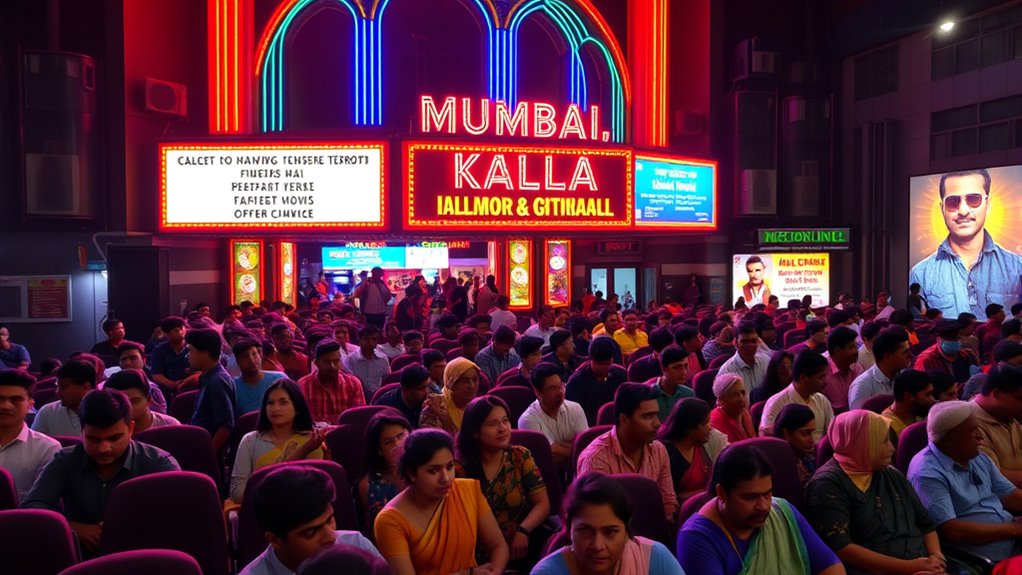
Ever wondered who makes up Bollywood’s movie audiences and how they influence box office results? In India, the theatrical audience is growing fast, with about 157 million theatergoers in January 2024—more than pre-pandemic levels. The Hindi cinema audience alone reached 92.2 million, a 58% increase from 2022. Most viewers are young, aged 15-24, and from affluent urban backgrounds, driving trends and ticket sales. Regular moviegoers, watching three or more films annually, shape box office success more than casual viewers. Language preferences matter too; Hindi dominates, but Malayalam cinema is gaining ground. Your viewing habits, genre choices, and media consumption, including OTT platforms, directly impact which films succeed or flop at the box office.
External Factors Influencing Box Office Results
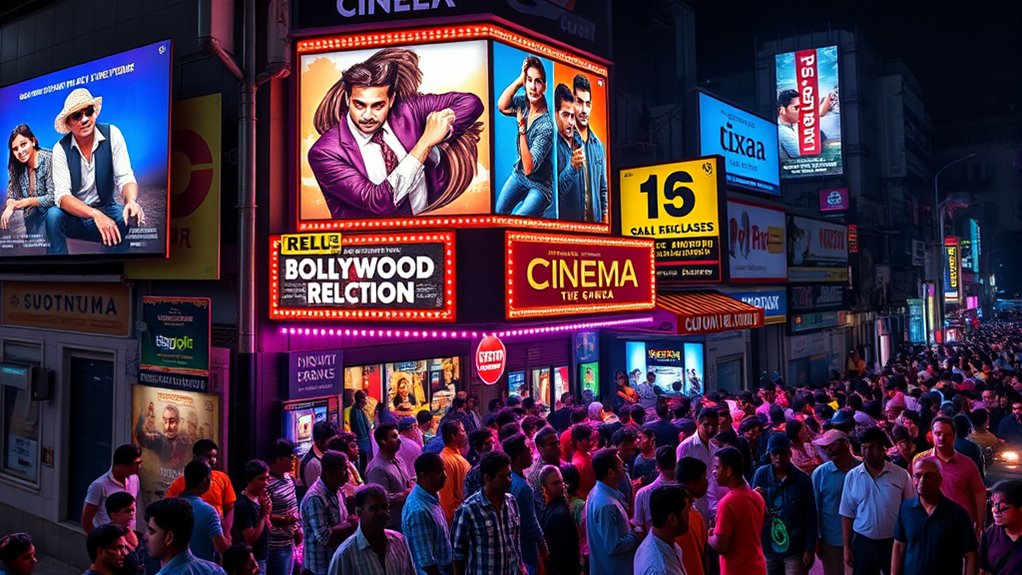
External factors beyond a filmmaker’s control can dramatically sway box office success or failure. These influences shape how audiences respond and whether a film hits or flops. Here are four key factors:
- Global health crises and pandemics – COVID-19 led to theater closures, delayed releases, and reduced footfall, making box office numbers unpredictable.
- Political and national security concerns – Heightened tensions or unrest can suppress audience turnout and cause delays or bans.
- Economic and regulatory shifts – Increased ticket taxes and multiplex dominance influence audience spending and access, especially for smaller films.
- Technological and distribution changes – OTT platforms, social media buzz, and evolving release strategies can divert attention from theaters or boost visibility quickly.
These external forces often overshadow a film’s content, impacting its commercial fate.
The Role of Sequels and Franchises

Sequel and franchise trends have reshaped Bollywood’s box office landscape, often overshadowing standalone films. You’ll notice that sequels like Gadar 2, Raid 2, and Drishyam 2 consistently outperform their original versions, drawing in larger audiences and earning higher collections. Top stars like Ajay Devgn anchor these projects, boosting both opening weekend and total revenue. Fans appreciate familiar characters and expanded stories, which create anticipation and loyalty. Franchises tend to stick to proven genres, reducing risk for producers while appealing across generations. Despite mixed critical reviews—often lower IMDb ratings—sequels thrive commercially due to strong marketing and star power. For filmmakers, this trend offers a strategic advantage, as franchises build long-term brand value, attract repeat viewers, and open lucrative merchandising opportunities.
Budget, Profitability, and Financial Viability

Bollywood films vary widely in budget, but success often depends on smart cost management and strategic investment. You’ll find that some movies thrive with modest budgets, while others need bigger investments to succeed. Consider these key factors:
- Budget allocation: Balancing production, marketing, and advertising costs is essential.
- Profit margins: Films like “Premalu” earned 45 times their budget, proving high profitability is possible with low costs.
- Regional films: Lower budgets don’t limit success; regional cinema often yields significant profits.
- Quality over quantity: Higher budgets don’t guarantee hits—smart storytelling and marketing are indispensable.
Managing costs effectively and focusing on quality can turn even modest investments into box office successes, ensuring long-term financial viability.
Frequently Asked Questions
How Do Critical Reviews Influence Bollywood Box Office Success?
Critical reviews influence Bollywood box office success mainly through their impact on audience perception and word-of-mouth. When reviews are positive, you’re more likely to recommend the film, boosting ticket sales. However, for big movies, reviews don’t always matter much during opening weekends due to marketing and star power. Instead, reviews tend to affect smaller films more, shaping long-term performance and audience trust.
What Role Do Social Media Trends Play in Box Office Performance?
Social media trends hold the power to make or break a Bollywood film overnight. You see, when you share, comment, or participate in hashtag contests, you create a ripple effect that skyrockets a film’s visibility. Stars’ social media buzz can turn a small release into a blockbuster, while a lack of online hype can doom even the most promising movies. Your digital engagement shapes the box office’s fate more than ever before.
How Does International Audience Reception Impact Indian Film Collections?
International audience reception directly influences Indian film collections by expanding a film’s reach beyond domestic borders. When global viewers connect with the story, cultural themes, or stars, it boosts box office numbers in multiple countries. Effective marketing, subtitles, and social media buzz help attract these audiences, increasing revenue. As you understand what appeals internationally, you can better target strategies to maximize a film’s global success and overall box office performance.
What Is the Significance of Film Duration on Box Office Sales?
Think of film duration like a tightrope walk—balance is key. You’ll find that longer movies can deepen storytelling but risk losing viewer interest, while shorter films might boost showtimes and audience engagement. Your goal should be to find the sweet spot where the length complements the story and audience preferences. This balance directly impacts box office sales, as it influences audience satisfaction, ticket sales, and repeat viewings.
How Do Post-Release Digital and OTT Strategies Affect Overall Profitability?
You see, post-release digital and OTT strategies substantially boost a film’s overall profitability. By releasing on OTT platforms after theatrical runs, you extend your audience reach, generate additional revenue, and recover production costs. Engaging marketing campaigns on social media and targeted ads keep viewers interested, encouraging repeat views. These strategies help offset box office shortcomings, attract international audiences, and create long-term brand value, making your film more financially successful.
Conclusion
Understanding what makes a Bollywood hit or flop isn’t just about numbers; it’s about the perfect blend of star power, content, timing, and audience connection. Do you think knowing these factors can help filmmakers predict success? By paying attention to these dynamics, you can better anticipate which films will thrive at the box office—and which might struggle. So, next time you watch a hit, remember, it’s more than luck—it’s strategy and insight in action.


